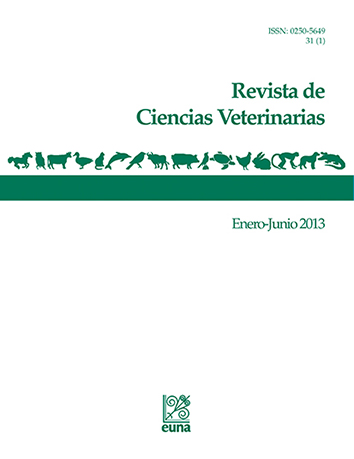Clinical management and therapeutic diagnosis of a presumptive case of canine immune-mediated hemolytic anemia
Keywords:
autoimmune, hemolytic anemia, canineAbstract
Autoimmune diseases (AID) continue to represent a major diagnostic challenge to veterinary practitioners and can be easily confused with other pathologies. It is the intent of this paper to exemplify this situation using a presumptive case of autoimmune hemolytic anemia, one of the most frequent autoimmune diseases in dogs. This case was referred to the Hospital for Wild and Minor Species from the School of Veterinary Medicine at Universidad Nacional (Costa Rica).
A seven year old female Australian Shepherd was admitted for a blood transfusion with a presumptive diagnosis of canine ehrlichiosis. However, based on lab results and the physical examination, a diagnostic of canine autoimmune hemolytic anemia was suspected. The patient was hospitalized for thirteen days and received the appropriate treatment according to the current literature. The patient´s evolution and response to therapy were monitored. The patient was discharged and eight months later neither adverse effects to the therapy nor recurrence of the disease were reported.
References
Blais, M.C. 2009. Blood Typing. In Blackwell´s Five-Minute Veterinary Consult: Laboratory Tests and Diagnostic Procedures: Canine and Feline. S.L. Vaden et al. editors. Wiley-Blackwell, Iowa.
Chervier, C., Cadoré, J.L., Rodríguez-Piñeiro, M.I., Deputte, B.L., and Chabanne, L.. 2012. Causes of anaemia other than acute blood loss and their clinical significance in dogs. J. Small Anim. Pract. 53:223–227. doi:10.1111/j.1748-5827.2012.01191.x.
Couto, C.G. 2009. Anemia. In Small Animal Internal Medicine. R.W. Nelson and C.G. Couto, editors. Mosby Elsevier, Missouri.
Eirman, L., and Michel, K.E. 2009. Enteral Nutrition. In Small Animal Critical Care Medicine. D.C. Silverstein and K. Hopper, editors. Elsevier Saunders, Missouri.
Giger, U. 2005. Regenerative Anemias Caused by Blood Loss or Hemolysis. In Textbook of Veterinary Internal Medicine. S.J. Ettinger and E.C. Feldman, editors. W.B. Saunders, Philadelphia. 1886–1807.
Giger, U. 2009. Blood Typing an Crossmatching. In Kirk´s Current Veterinary Therapy XIV Edition. Bonagura, J., and D. Twedt, editors. Saunders-Elsevier, Missouri. 260-265.
Ishihara, M., Fujino, Y., Setoguchi, A., Takahashi, M., Nakashima, K., Ohno, K., and Tsujimoto, H. 2010. Evaluation of prognostic factors and establishment of a prognostic scoring system for canine primary immune-mediated hemolytic anemia. J. Vet. Med. Sci. 72:465–70.
McAlees, T.J. 2010. Immune-mediated haemolytic anaemia in 110 dogs in Victoria, Australia. Aust. Vet. J. 88:25–8. doi:10.1111/j.1751-0813.2009.00537.x.
Miller, E. 2009. Immune-mediated Hemolytic Anemia. In Kirk´s Current Veterinary Therapy XIV Edition. Bonagura, J. and D. Twedt, editors. Saunders-Elsevier, Missouri. 266-271.
Downloads
Published
How to Cite
Issue
Section
License
Licensing of articles
All articles will be published under a license:

Licencia Creative Commons Atribución-NoComercial-SinDerivadas 3.0 Costa Rica.
Access to this journal is free of charge, only the article and the journal must be cited in full.
Intellectual property rights belong to the author. Once the article has been accepted for publication, the author assigns the reproduction rights to the Journal.
Ciencias Veterinarias Journal authorizes the printing of articles and photocopies for personal use. Also, the use for educational purposes is encouraged. Especially: institutions may create links to specific articles found in the journal's server in order to make up course packages, seminars or as instructional material.
The author may place a copy of the final version on his or her server, although it is recommended that a link be maintained to the journal's server where the original article is located.
Intellectual property violations are the responsibility of the author. The company or institution that provides access to the contents, either because it acts only as a transmitter of information (for example, Internet access providers) or because it offers public server services, is not responsible.







